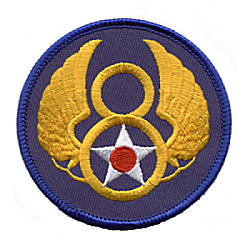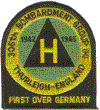13 Feb 8th Air Force

8th Air Force patch
The 8th Army Air Force was activated as part of the U.S. Army Air Forces January 28, 1942, at Hunter Field in Savannah, Georgia. Pearl Harbor had just been bombed about a month and a half earlier. Soon afterwards, headquarters moved to England to prepare for bombardment missions against Nazi-occupied Europe. The bomber groups began to occupy airbases handed over to them by the Royal Air Force who had been fighting Nazi Germany since 1940.
At its peak, the 8th AF could dispatch more than 2,000 four-engine bombers and 1,000 fighters on a single mission. For these reasons, the 8th AF became known as the “Mighty Eighth“. I found a combat drawing online at www.taphilo.com which shows the flight patterns aircraft used to assemble before a mission. “By the summer of 1944 it could take up to two hours for all three bomber divisions arranged and in formation from the first aircraft takeoff to when the lead aircraft starts leading the bomber stream toward enemy airspace.” The Drawing. Just imagine that this was all coordinated without computers and without GPS.

306th BG patch
Herman’s crew was assigned to the 368th Squadron of the 306th BG (Bomb Group Heavy) at Thurleigh airfield. This was part of the 40th Combat Wing of the First Air Division (all B-17’s.) Note the “H” on the 306th BG patch. The “H” was painted on the tail of the B-17’s that flew out of Thurleigh.
When I read this on page 6 of Donald Miller’s book, Masters of the Air, America’s bomber boys who fought the air war against Nazi Germany, I emailed my family immediately and expressed what a miracle it was that our Dad beat the odds and lived through this to return to the US.
“In October 1943, fewer than one out of four Eighth Air Force crew members could expect to complete his tour of duty, twenty-five combat missions. The statistics were discomforting. Two-thirds of the men could expect to die in combat or be captured by the enemy. And 17 percent would either be wounded seriously, suffer a disabling mental breakdown, or die in a violent air accident over English soil. By the end of the war, the Eighth Air Force would have more fatal casualties – 26,000 – than the entire US Marine Corps. Seventy-seven percent of the Americans who flew against the Reich before D-Day would wind up as casualties.”


Barbara Ann
Posted at 19:57h, 13 FebruaryThose statistics are staggering……
God wanted Herman around and God blessed us with the best Dad in the world.
Thank you, God!